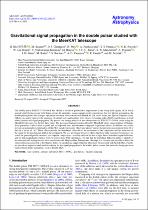| dc.description.abstract | The double pulsar PSR J0737−3039A/B has offered a wealth of gravitational experiments in the strong-field regime, all of which
general relativity has passed with flying colours. In particular, among current gravity experiments that test photon propagation, the
double pulsar probes the strongest spacetime curvature. Observations with MeerKAT and, in the future, the Square Kilometre Array
(SKA) can greatly improve the accuracy of current tests and facilitate tests of next-to-leading-order (NLO) contributions in both
orbital motion and signal propagation. We present our timing analysis of new observations of PSR J0737−3039A, made using the
MeerKAT telescope over the last three years. The increased timing precision offered by MeerKAT yields a measurement of Shapiro
delay parameter s that it twice as good, and an improved mass measurements compared to previous studies. In addition, our results
provide an independent confirmation of the NLO signal propagation effects and already surpass the previous measurement from 16 yr
data by a factor of 1.65. These effects include the retardation effect due to the movement of the companion and the deflection of
the signal by the gravitational field of the companion. We also investigate the novel effects that have been expected. For instance, we
search for potential profile variations near superior conjunctions caused by shifts of the line of sight due to latitudinal signal deflection,
and we find insignificant evidence with our current data. With simulations, we find that the latitudinal deflection delay is unlikely to
be measured with timing because of its correlation with Shapiro delay. Furthermore, although it is currently not possible to detect the
expected lensing correction to the Shapiro delay, our simulations suggest that this effect may be measured with the full SKA. Finally,
we provide an improved analytical description for the signal propagation in the double pulsar system that meets the timing precision
expected from future instruments such as the full SKA. | en_US |

